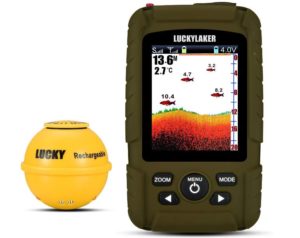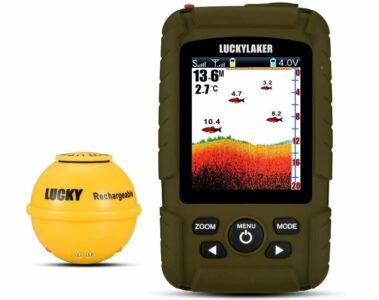 You might be aware of traditional sonar imaging and structure down scan.
You might be aware of traditional sonar imaging and structure down scan.
Generally, traditional sonar is considered better for picking up fish arches and bait balls, whereas the structure down scan, as the name suggests, is better for picking up structures such as sunken trees or drop-offs.
As far as traditional sonar is concerned, fish usually appear as arches. The large arch on the bottom left of the screen can clearly be seen and that’s what we call a big fish. The rule is simple, smaller the fish the harder it becomes to make it out compared to traditional sonar. Structure down scan is specifically designed to pick up a more detailed structure with fish returns more dotted.
The ‘return’ is actually the image that a piece of structure or fish makes on the fish finder display screen. A ‘hard’ return shows a hard surface such as compacted sand or rock and displays as bright yellow, according to the colour palette.
How exactly does sonar work?
The term Sonar we usually hear while discussing fish finders stands for Sound Navigation and Ranging. It matters a lot on the model you choose, you can go for a fish finder that is equipped with marine radar, GPS, and a compass to help you find the way when you’re on a boat.
Most of the fishfinders use sound to identify objects underwater. They typically work by sending out sound pulses and waiting for an echo. Plus, the frequencies used vary, usually ranging from very low to very high.
How fishfinder is different from sonar
Sonar is actually a high-performance horizontal fish finder that is capable of detecting and showing the distribution of fish schools in all directions around your vessel. Whereas Fish Finders are more focused on detecting echoes under the ship, Sonars detect schools of fish all around the ship. This makes it one of the most effective ways to search for fish.
How to read a sonar fish finder with ease
The first most important thing you need to know while reading a fish finder is the most recent information which is displayed on the right-hand side of the screen. The provided information then slowly moves to the left as it is replaced with fresher data. So, this is what happens, a screen effectively displays a slice of the water column over a period of time.
Bottom depth of the water
Your fish finder is capable of showing the bottom depth of the water you are in, in most cases, on the top-left or right-hand side of the screen. As you are stationary in the water, there would be no change in depth. You can make use of the numbers that you see down the side of the screen to study the depth of anything else in the water.
So, If you were moving around in the water, the bottom depth would keep on changing constantly. As you move, you would be able to find honey holes or drop-offs in new bodies of water by trolling around in your boat slowly.
Underwater objects that are not fish
Obviously, not everything your fishfinder shows will be fish. You should know that a fish finder will also pick up underwater structures. The most appropriate way to tell underwater objects from fish is by identifying whether or not the item looks like it’s attached to the bottom or not.
How to identify fish
As a matter of fact, it heavily depends on the type of fish finder you have, the fish would normally either appear as arches or as fish icons on the screen. Some advanced and modern fish finders have Fish ID technology, which will show fish icons in the places where it thinks fish are. Well, it’s also true that not even the most advanced units will be right 100% of the time. Hence, many keen anglers are comfortable in reading the information for themselves.
In case, If your fish finder is not equipped with Fish ID technology or have it switched off, then keep in mind that a fish will usually appear on your sonar display as an arch. Also, don’t get confused, as the screen helps you see underwater activity over a certain period of time, so a longer arch doesn’t mean a bigger fish.
Well, a longer arch normally represents that a fish was swimming slowly through a transducer’s field of vision. Same like this, a shorter arch will be shown for a fish that was swimming more quickly. In case if a fish was stationary in the water, your screen will show a long straight line.
Not only that, a fish might only swim part of the way through your transducer cone’s vision. if this happens, it normally doesn’t appear as a full arch. With full arches, you will also notice half arches that may represent fish. This simply means that the quality or fullness of the arch has nothing to do with size. It’s all about the width of the line you see that actually informs you more about the fish size.
- What Do You Need for Fishing - August 18, 2022
- How to Find Offshore Fishing Spots - August 18, 2022
- What to Use for Trout Fishing - August 17, 2022

